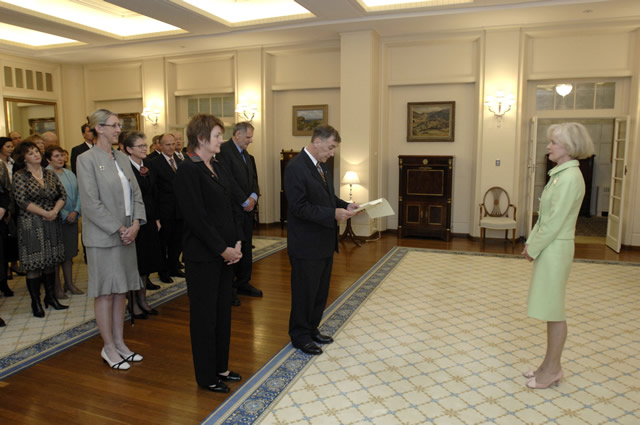172 Presentation of address
-
Addresses to the Queen shall be transmitted to the Governor-General by the President, requesting that they be forwarded for presentation.
-
Addresses to the Governor-General shall be presented by the President, unless the Senate otherwise orders.
-
When an address is ordered to be presented by the Senate, the President, accompanied by senators, shall proceed to the place the Governor-General appoints, and, being admitted to the Governor-General’s presence, the President shall read the address to the Governor-General, the senator who moved the address being with the President.
-
The Governor-General’s answer to an address presented by the Senate shall be reported by the President.
Amendment history
Adopted: 19 August 1903 as SOs 358 to 361 (corresponding to paragraphs (1) to (4)) but renumbered as SOs 354 to 357 for the first printed edition
Amended: 26 November 1981, J.716–17 (removal of reference in paragraph (3) to seconding by replacing “senators who moved and seconded” with “senator who moved”)
1989 revision: Old SOs 368 to 371 combined into one, structured as four paragraphs and renumbered as SO 172; expression streamlined, language modernised and superfluous detail removed – such as the reference to the mover standing to the left of the President when presenting the address
Commentary
The four precursor standing orders were based on those of the South Australian House of Assembly and were adopted without debate in 1903. The presentation of an address to the Governor-General remains one of the few choreographed practices of the Senate, along with openings of Parliament, the swearing-in of senators, and the transmission to and receipt of messages from the House of Representatives. Such practices are a link to past traditions but they also stand as a challenge to advocates of parliament solely as an institution of contemporary relevance. Their continued survival reflects the inherent conservatism of the parliamentary institution where useful tradition happily co-exists with pragmatic, flexible and fair procedures.

Presentation of the Address-in-Reply by the President of the Senate, Senator the Hon. John Hogg, to the Governor-General, Ms Quentin Bryce AC, at Government House on 22 September 2008 (Photo courtesy of AUSPIC)
When an address is to be presented to the Governor-General, the President invites all senators to accompany him or her and announces where the Governor-General will receive them. In recent decades, this has invariably been at Government House which is a short drive from Parliament House. Practical arrangements are also announced and the Senate is suspended while the presentation occurs.
Despite the 1981 amendment, the address-in-reply to the Governor-General is initiated by a motion that is still seconded by convention.[1] As a consequence, both the mover and the seconder of the motion stand with the President when he or she presents the address. Behind them stand the Clerk and Deputy Clerk of the Senate, then the Usher of the Black Rod, then senators who have accompanied the President to the presentation. The President reads the address; the Governor-General says a few words in acknowledgment; and senators and officers are introduced by the President to the Governor-General.
When the Senate resumes, the President reports the presentation of the address and the Governor-General’s response which is usually an indication that the Governor-General will convey the address to the Queen.[2]